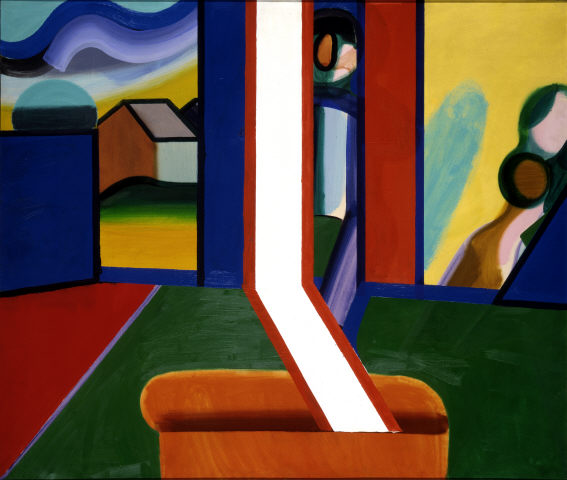
- 1969
- Canvas
- Oil
- Inv. PE223
Howard Hodgkin
Mr. and Mrs. Patrick Caulfield
Mr. and Mrs. Patrick Caulfield belongs to a series of encounters Hodgkin had with couples in the 1960s London art scene which he was part of, in this case with the painter Patrick Caulfield and his wife. In these paintings, Hodgkin seeks to summon up a moment frozen in time, concentrating on evoking the atmosphere of the encounter, and so leading the viewer into a dialogue with the depicted space (frequently a closed, interior space). The viewer thus takes as a point of departure the figurative coordinates which the painter blends with abstract elements inspired by the recent North-American hard edge and post-painterly painting. The hard-edge white stripe bordered with red that vertically dissects the composition, sets over the edge of an orange couch represented in the foreground. The interior space of the living room is thus articulated between the right side of the image, occupied by the Caulfield couple, and the left side, with a compositon of juxtaposed colour fields which opens onto a stylized and suggestive sunset landscape.
The figures, almost silhouettes, of Patrick and Mrs. Caulfield (nameless and faceless) are separated again by a new red hard-edge stripe next to its complementary purple, next to Patrick, who has stopped, voyeuristically, on his way towards a kind of illuminated window where we see his wife. This outline of uniform width is used in black to delineate various flat areas of brilliant colour, in a clear reference to Patrick Caulfield’s paintings where black outlines are frequently used to define figures (which are themselves quite obvious citations to the paintings of Fernand Léger and Stuart Davis, and to the language of advertisement and comics).
For Hodgkin, these paintings should, ideally, be like “memorials”; in physical terms and, as far as possible, they should be finite, solid objects free from any irrelevant or confusing elements.
Ana Vasconcelos
March 2013
| Type | Value | Unit | Section |
| Height | 109 | cm | |
| Width | 128 | cm | |
| Depth | 3,3 | cm | |
| Height | 107 | cm | |
| Width | 127 | cm |
| Type | Acquisition |
| A Ilha do Tesouro / Treasure Island |
| CAMJAP/FCG |
| Curator: CAMJAP/FCG |
| 7 de Fevereiro de 1997 a 4 de Maio de 1997 Todo o espaço expositivo do CAM - pisos 0, 1 e 01, e Galeria de Exposições Temporárias. |
| Comissários da exposição: Jorge Molder e Rui Sanches. |
| Metamorphosis - British Art of the Sixties: works from the collections of the British Council and the Calouste Gulbenkian Foundation |
| Basil & Elise Goulandris Foundation - Museum of Contemporary Art |
| Curator: Fleurette P. Karadontis |
| 26 de Junho de 2005 a 25 de Setembro de 2005 Basil & Elise Goulandris Foundation - Museum of Contemporary Art |
| Comissários da exposição: Richard Riley, British Council, London, e Ana Vasconcelos e Melo, CAMJAP-FCG, Lisboa. |
| The Gulbenkian Foundation and British Art |
| Tate Britain |
| Curator: Tate Britain |
| 1 e 10 de Março de 2006 a Fevereiro de 2007 Londres, Tate Britain |
| A exposição fez parte das comemorações dos 50 anos da Fundação Calouste Gulbenkian que começaram oficialmente a 18 de Julho de 2006. |